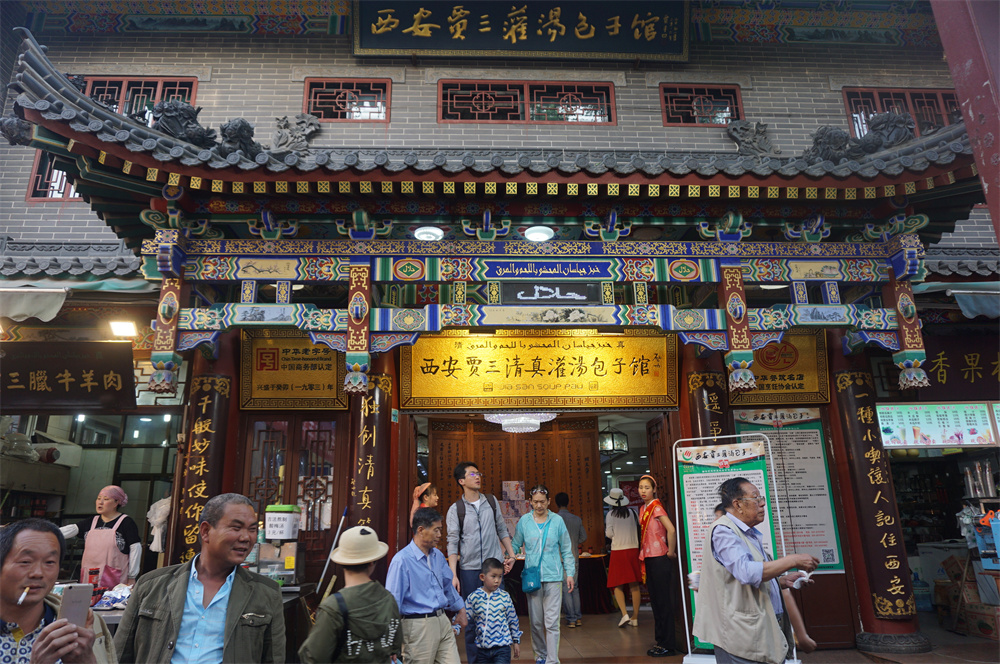
Moslem Street (Huimin Jie) Just as its name implies, Moslem Street is the hub of the Moslem community in Xian City, Shaanxi Province. Located beside the Drum Tower, it is about 500 meters long from south to north. This street is paved with dark colored stone with green trees providing heavy shade during summer; the buildings on both sides of the street are modeled on the styles of both the Ming and the Qing Dynasties. Some of the constructions are restaurants; while others are stores. But here there is one thing in common: the owners are all Moslems.
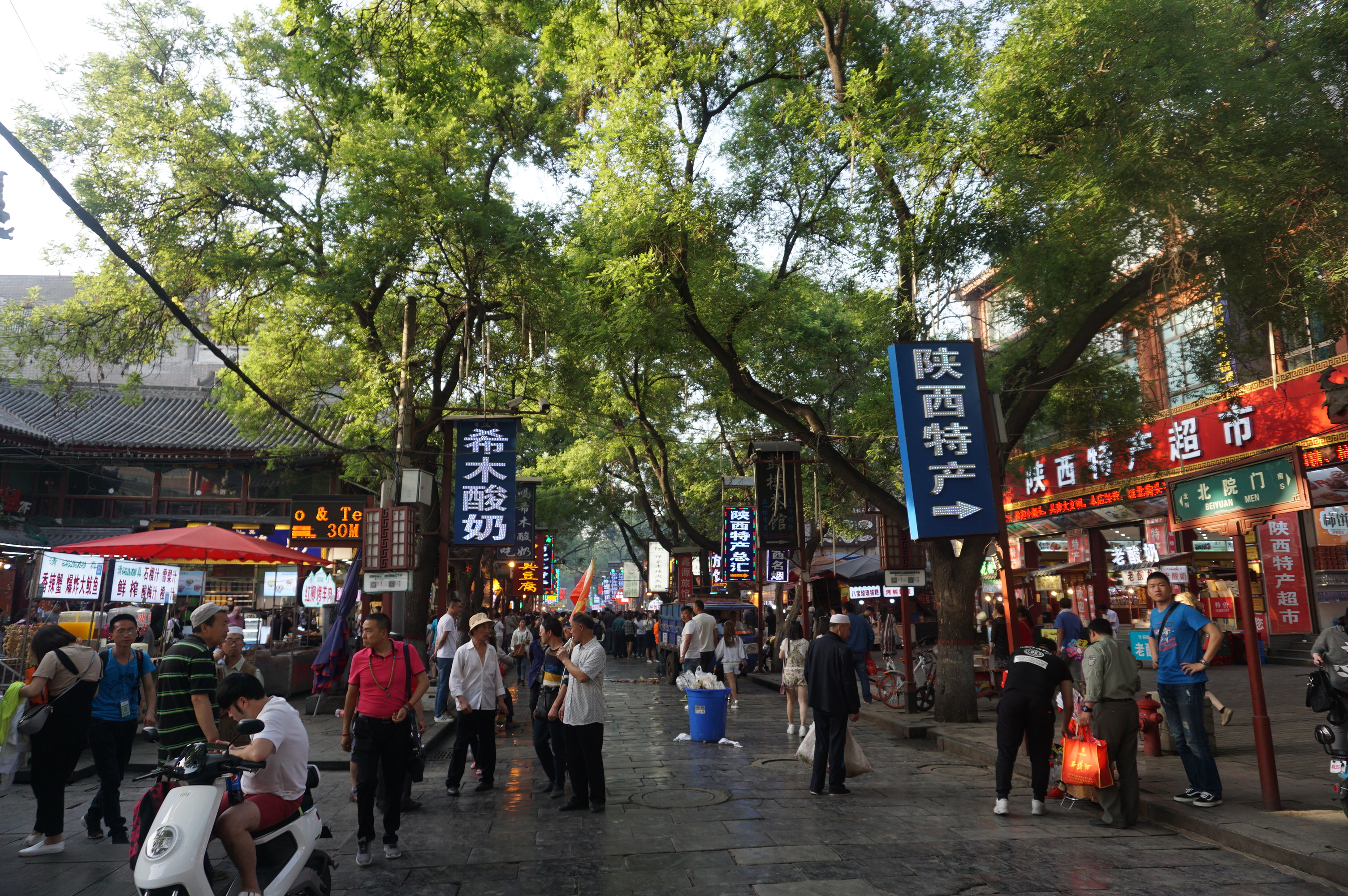
Walking along this twisted, narrow street which is aligned with stores on both sides, you can see that Moslem men with white hats sit inside the stores and talk leisurely with each other. In front of the doors of some stores, old men with white beards sit on the cane chairs enjoying the tender touch of the sun and having fun with the little children running along the street. The main goods of these stores are authentic hand-making Moslem food which tastes very good. While still there are small stores selling the special local products of Shaanxi Province and yet others provide you with exquisite souvenirs.

It is stated that once you have been to Moslem Street, you won't feel regretted for the snacks of Xian. Yang Rou Pao Mo is a very distinctive snack of Xian, and is extremely delicious. Fried rice with pickled Chinese cabbage and little capsicum is extremely savoury. And it is a real enjoyment for you to eat it on a hot summer's day. Roast beef, mutton or lamb is another snack that can make your mouth water. After roasting on fire with some flavorings on the meat, it is ready for you to enjoy. While the most famous snack on this street is the steamed stuffed bun of Jiasan. The main ingredients of the steamed stuffed bun here are beef or mutton mixed with the soup decocted from the bones of sheep or cattle.
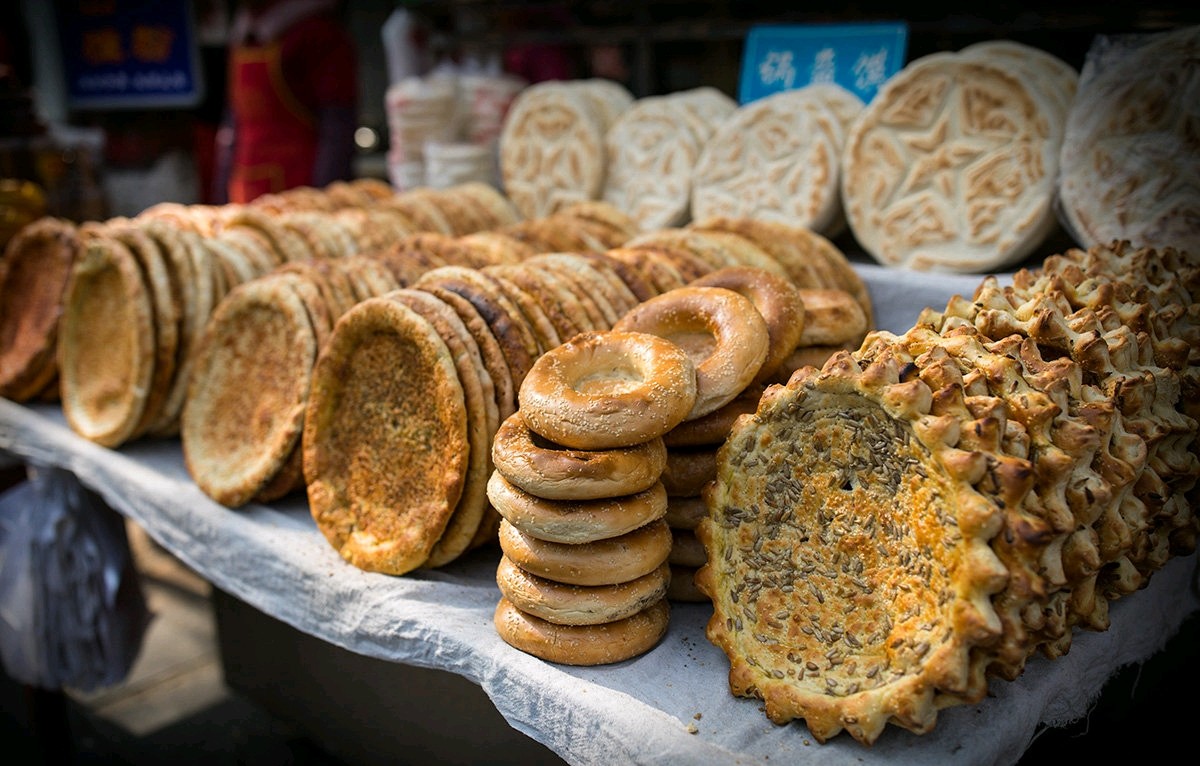
There are also fruit pies made with persimmon here which are considered as the unique refreshment in Xian. These pies take the bright red, glittering and translucent persimmons from the Lintong District of Xian City, Shaanxi Province as the basic ingredients. When making the pies, firstly people will get rid of the skin of the persimmons, pounding the flesh, mixing it with flour, then putting the sweet-scented osmanthus and white sugar inside as the stuffing, then frying them in oil until they are cooked. When eating them, you will feel savory, sweet and soft.
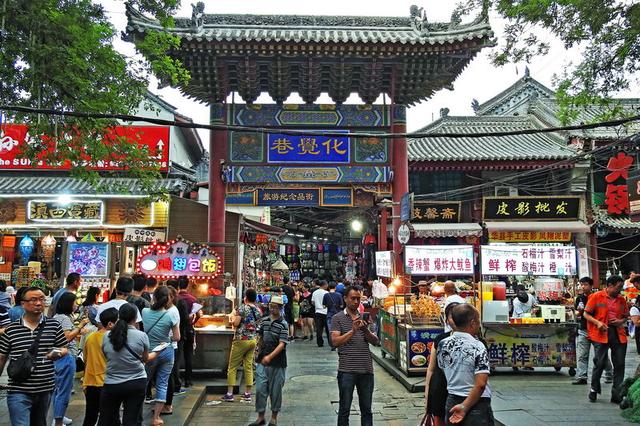
There are also a great many other snacks to be found along this street, such as preserved meat, casserole, various noodles, and so on. They are waiting for you to enjoy
The Great Mosque at Huajue Lane

The Mosque is a major spot for religious activities of over 60.000 Moslems in Xi'an, likewise, an important cultural relic protected by the Provincial People‘s Government. Unlike the Arabic mosques, with splendid domes, the minarets reaching into the clouds, the coulourful engraved sketches with dazzling patterns, the Mosque here in Xi'an possesses much Chinese traditional touch in both its design and artistic outlook; besides the style peculiar to Islamic mosques, this Mosque also holds characteristics of Chinese pavilions with painted beams and engraved ridgepoles.
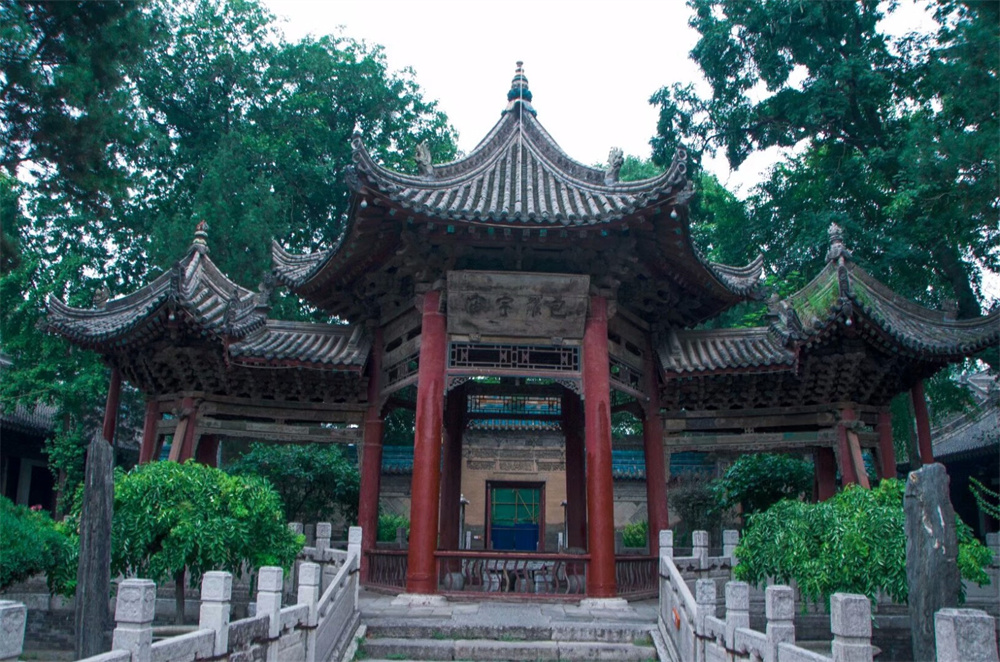
However, any further discussion about the Mosque will be futile unless anything of the introduction of Islam into China is brought up.
Islam as a religious order was founded in the early period of the 7th century A.D. and was introduced to China in the mid-600s. At that time, Arabian merchants and travelers came to the northwest of China by way of Persia and Afghanistan and thus established diplomatic, trade, and military contacts with China. In the meantime, another route saw a batch of sea voyagers through Bangladesh Bay and the Malacca Strait to China's Guangzhou, Quanzhou, Huangzhou, Yangzhou and other cities where many of them settled down and married the local women who later gave birth to babies who then became Moslems.
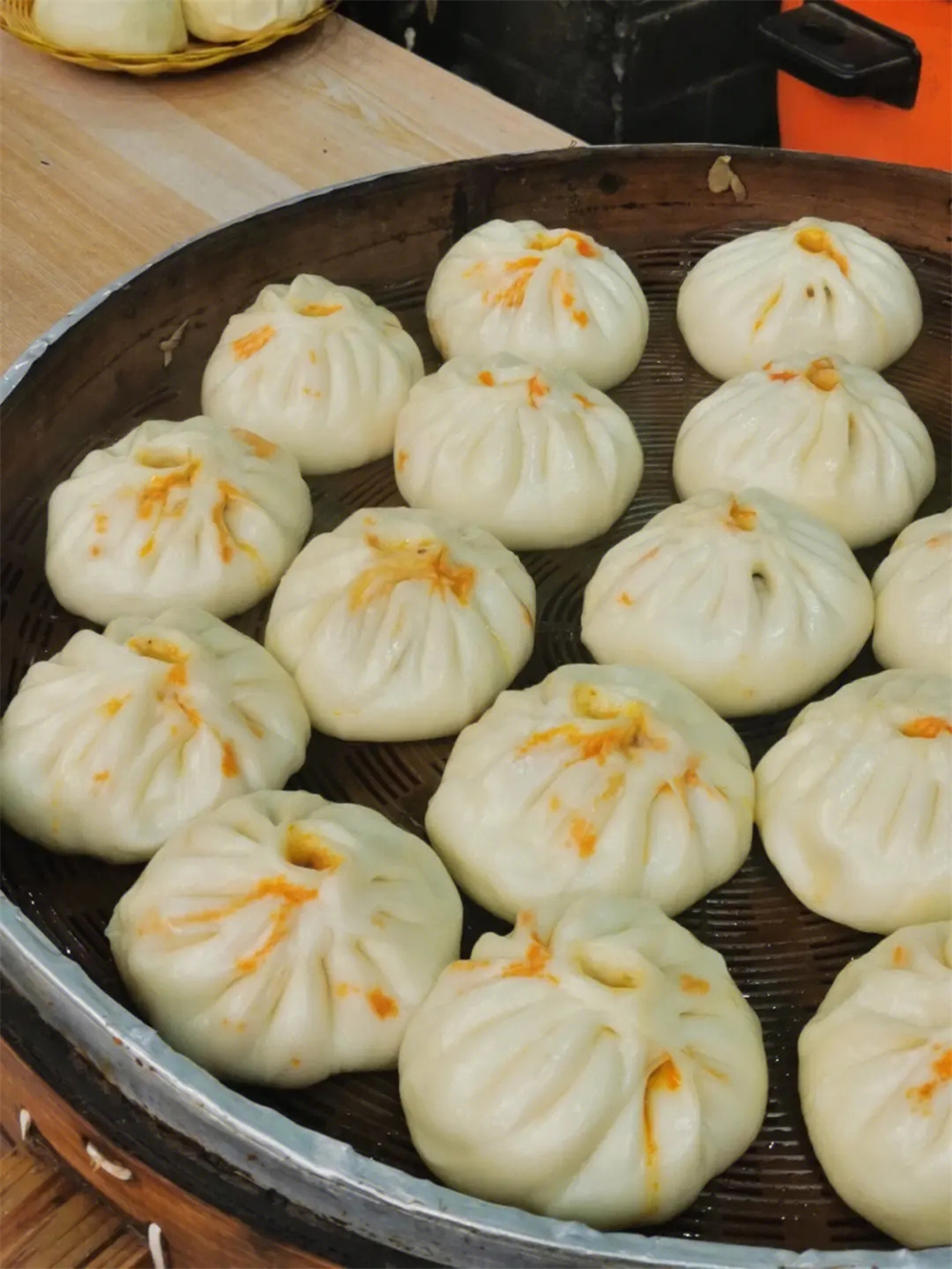
However, massive immigration of the Moslems to China did not take place until as late as the early period of the 13th century, when Genghis Khan, as a result of his expedition against the west, had conquered vast expanses of land stretching from Central Asia to Eastern Europe, including the north of Iran. Many of the Moslems in the conquered areas were thus forced to enlist and later settled in China.
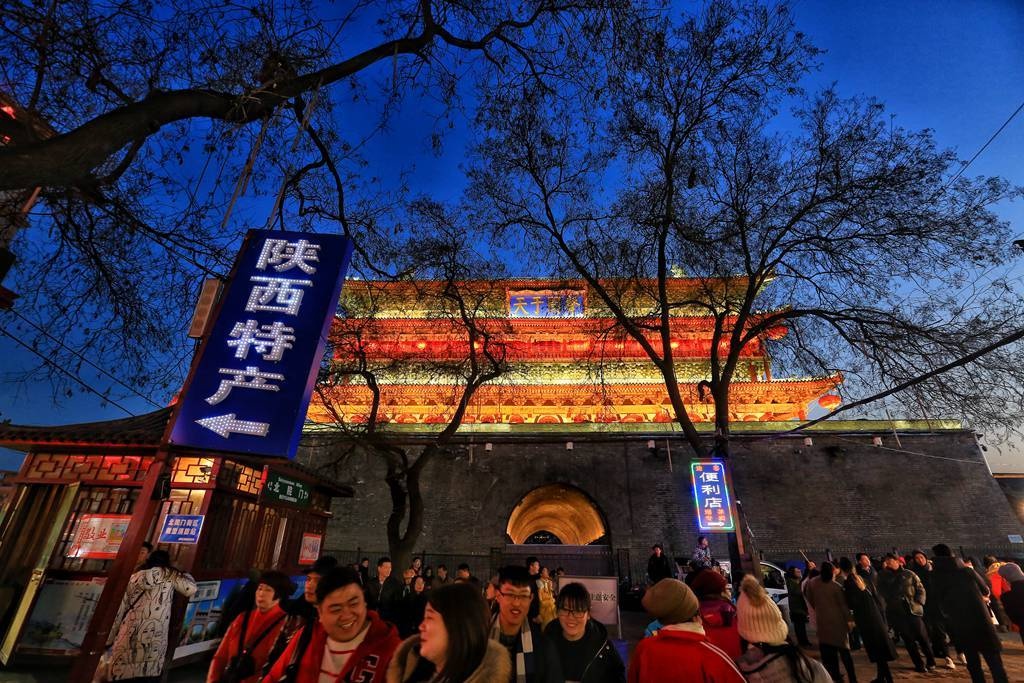
Among the enlisted many were soldiers, and some were smiths and officials who were called the Hui people in the history books on the Yuan dynasty. The Hui people later followed Kublai Khan down to the south, helping him unifying China and then establish the Yuan dynasty. In the wake of the conquest, Islam spread all over China and mosques began to appear everywhere. In the Yuan dynasty, many Moslems held positions both in the military and civilian organs of the country. And a lot of the Moslems took part in Zhu Yuanzhang's uprising in the early 14th century and made great contributions to the founding of the Ming Dynasty. Therefore, all the emperors of the Dynasty issued mandates to protect Islam, and to set up mosques in praise of the Moslems for their feats. In the early 16th century, Islam predominated Qinghai on the minority nationalities including the Huis, the Uygurs, the Kazaks, the Kirgizes, the Tajiks, the Tartars, the Ozbeks, the Dong Xiangs, the Salars and the Bonans. The Moslems in Xi‘an are mainly the Huis, being a small portion out of the ten million in China.
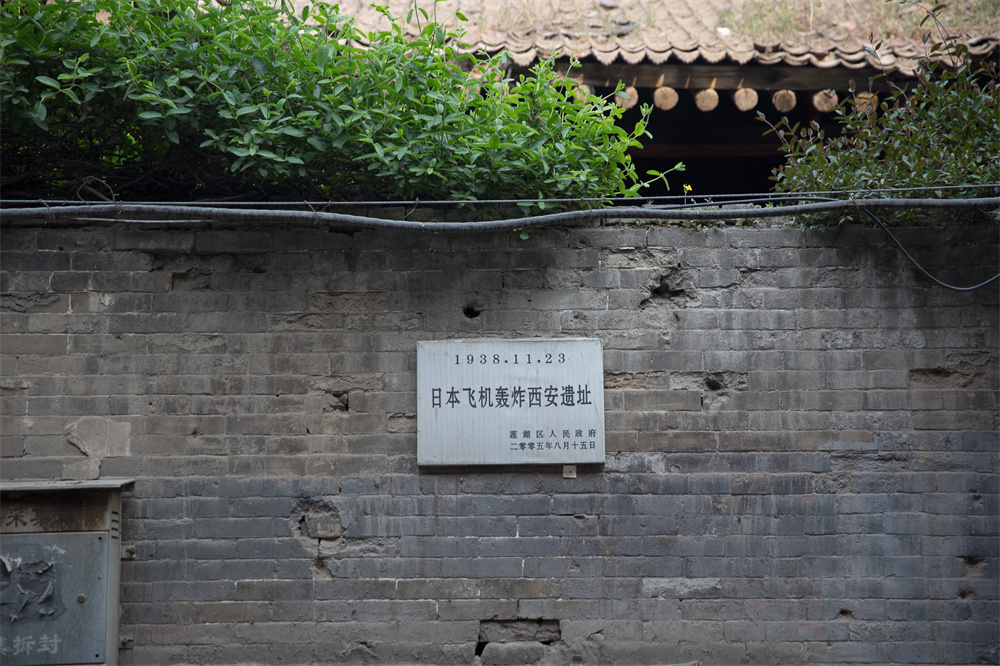
The Mosque at Hua Jue Lane is the largest in Xi'an, and at the same time, it is also one of the earliest built on a comparatively large scale, and well preserved mosques in China.

According to “the Stele on the Building of the Mosque”, the mosque is said to be built in the Tang Dynasty. However, the architectural style of the mosque suggests a possible building dating back to the Ming Dynasty. The four courtyards of the mosque cover an area of more than 12,000 square meters, out of which about 4,000 are occupied by various structures. The still intact wooden front memorial gateway of the front yard, built at the turn of the 17th century, with glazed tiles on the top, spectacular corners and upturned eaves, is about 9 metres high, and has a history of about 360 years. The stone memorial gateway in the center of the second courtyard is flanked with a tail stele on either side with dragons carved on each, recording the repair work ever since the building of the Mosque. On the back of one of the steles are engraved characters by the master calligrapher Mi Fu, “May Buddhism Fill the Universe”, on the other, “Royal -Bestowed”by Dong Qichang, another master of the same art of the Ming dynasty. They are treasures in Chinese calligraphy. At the entrance of the third courtyard is an imperial built hall, where a “month tablet”, showing the calculation of the Hui Calendars in Arabic, is stored. It was compiled by a man in charge of the mosque called Xiao Mining in the early period of the Qing dynasty. A three –storeyed octagonal wooden structure called “Retrospection Tower”also stands in the center of the courtyard, which has the same function as the minaret in Islamic temples in Arabic countries, and which is a place from where orders were sent to call the Moslems to come to worship. Respectively, on the south and north wings of the tower, are a reception chamber and a Scripture Chamber, both elegantly laid out. The five wooden houses, which are called “Water Houses”in the southwest section of the Mosque are the place where the believers bathe themselves before they attend their services. And in side the fourth courtyard there is a structure called “the Pavilion of Phoenix”, a place where the worshipers used to wait for the services. The Pavilion, in fact, is a compound structure of three small buildings. The six-gabled structure of the central part, adjoining the two three-gabled buildings on each side looks very much like a flying phoenix, and hence its name. Just at the back of the Pavilion, there is a fishpond, beyond which is a platform occupying an area as large as 700 m2. Across both ends of the platform stands the 1,300 square metered service hall, holding over a thousand worshipers at once. There are over six hundred sunk panels well as the sunk panels, are decorated with patterns of painted trailing plants and Arabic letterings. The imam leads his group of worshipers, while facing in the direction of Mecca, to chant in Koran and to pay their religious homage.
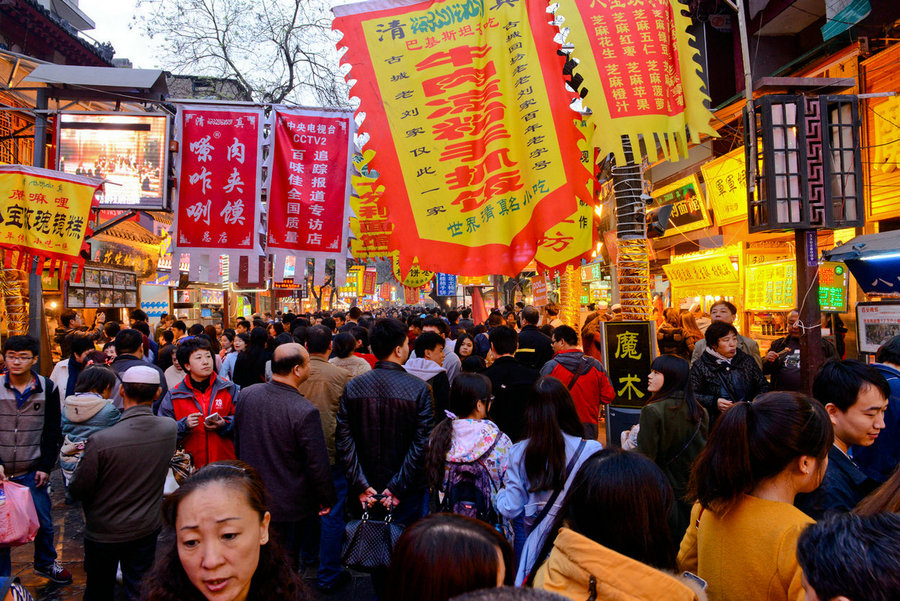
The Moslems in China share very much the same customs with their brothers and sisters elsewhere in the world. They worship five times a day: at dawn, at noon, in the afternoon, at dusk, and at night. Female worshipers attend their services in a separated place from their brothers, usually at home. Moslems pay special attention to their health and see that they always wear clean clothes. They are teetotalers not only of wine, but also of pork and animal blood for in Koran pigs have been mentioned four times as being “unclean”. According to Koran, a man can have four wives and women should wear veils when they go out. However, except a few places in Xinjiang, the Chinese practise monogamy and women are veiless when they go out. Upon his death, a Moslem has to be “thoroughly cleaned”(thoroughly bathed), has to be put on “Ke Fan”(to be shrouded with a piece of white cloth) and has to be buried coffinless in the ground, with an imam reciting Scriptures at the funeral.

The Chinese constitution promulgates that freedom of religion of each citizen and freedom of preserving or reforming local customs for every nationality are permitted. And of course, the Moslems in China enjoy equal rights with peoples of other nationalities and their religious beliefs and customs are respected everywhere in the country.
